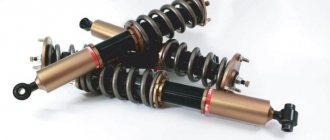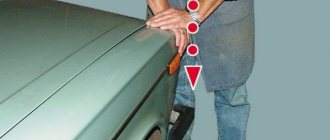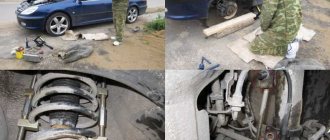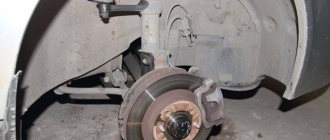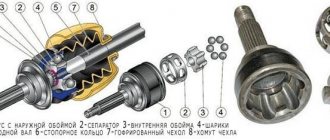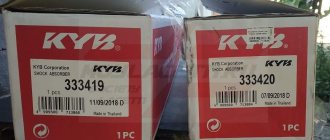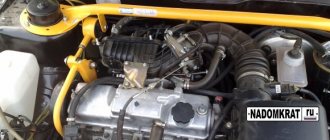The information in this article will be as useful and informative as possible for car enthusiasts who are just beginning to study the design features of a car. The question of what front shock absorber struts are, what is the importance of these elements, and how to replace them when they wear out or break down will be covered in detail.
The device of the front shock absorber struts
Many drivers mistakenly draw a parallel between concepts such as a shock absorber strut and the shock absorber itself. Some of them believe that this is an ordinary spring, or call all the elements of this system assembled together a strut. To understand that this is an erroneous opinion, it is worth studying in more detail the question of what racks are and what features of their design are present.
A shock absorber strut is a component that is required to connect components such as the body and wheels of a vehicle. This support is connected to a spring and a damper, which, by the way, is the main component of the shock absorber.
This design contains the following elements:
- Cylinders containing a piston and special hydraulic fluid.
- Hydraulic fluid, which can be presented in the form of a mixture of liquid and gas, as well as a certain mixture of gases. The composition is necessary to transfer forces between two types of shock absorbers.
- Stock. Designed to hold the piston on itself and is required to transmit serious pushing forces.
- A piston with a special bypass valve. It moves in the inside of the cylinder. Used for smooth transmission of vibrations.
- Seals, seal and high-quality sealant.
- An enclosure designed to house the various components of a rack inside.
- Fasteners necessary to connect the main parts of the shock absorber to the car body.
If you study the design of the elements, you can understand that the front shock absorber struts (AS) may or may not be equipped with springs. The choice of one or another option must be made based on the design features of the suspension and an acceptable budget.
Like all car parts, front shock absorber struts wear out over time, break and become completely unusable. If this phenomenon is detected, the front strut shock absorber should be replaced as soon as possible.
Top Five Tips When Replacing Struts or Shock Absorbers in Your Car
- When purchasing a new shock absorber, purchase a quality replacement.
- Always replace these mechanisms only in pairs (front or rear axle) to keep the suspension in balance, unless you need to replace a fairly new faulty unit.
- Even if you're replacing front or rear, always replace one unit at a time, as shock absorbers can help keep suspension components in place. You will avoid potential damage to other parts.
- When replacing the rear one, you will need access to the trunk or under the trim in the rear of the car.
When replacing, this guide can only give you a general idea of the actual process. However, the specific steps vary between brands and models. Although for some car models this manual will be what you need.
If you have no idea how this is done at all and have never seen it, then it is better to go to a service station and see with your own eyes how the process happens and only then try it yourself, since, for example, removing springs can be a very dangerous task and even lead to death if these parts are handled incorrectly. Be very careful and attentive.
The principle of operation of the front struts
To understand how the front shock absorber struts of a vehicle function, the MX should be divided into two main structural elements - a spring and a shock absorber. They are the ones who put the whole mechanism into action.
Spring
The main element of this part is designed to level out a variety of defects in modern road surfaces. It is also necessary to reduce vibration activity, which is reflected on the body during movement. When moving along a heavily broken road, it is thanks to the spring that the driver only feels the smooth rocking of the car. the spring absorbs the most powerful shocks, that is, completely dampens them.
The metal from which the spring is made must have optimal elasticity. Typically, the steel used is one that is optimally suited for a specific vehicle brand, its weight and general specialization.
The spring is installed with one side in a special cup of the rack, and the other part passes through a rubber spacer, which, in turn, rests against the body.
Shock absorber
This is the stand itself, which, when compared with the same spring, is a more complex part in its design. Here are the most basic design features:
- A two-chamber cylinder along which a piston moves, pre-attached to a rod. It is this that is filled with gas or liquid.
- The working composition circulates in the inside of both chambers, on the basis of which all struts, like standard shock absorbers, are divided into several types.
The main task of a shock absorber is to dampen vibrations that come from the spring. The depreciation procedure implies a serious increase in the level of pressure generated by the internal part of the part. Its reduction is carried out due to special valves, which are located directly on the piston. Depending on the general position, the elements automatically close and open so as to effectively regulate the applied loads.
This is interesting: Review of SsangYong Kyron
Technical educational program
It is the shock absorbers in the car's suspension that smooth out uneven road surfaces and tolerate aggressive driving. Shock absorbers are structurally different, but the comfort and safety of vehicle movement depend on their quality.
In addition to the shock absorbers themselves, the concept of “shock absorber struts” is distinguished. These are different things and should not be confused.
Structurally, a shock absorber is a cylinder with high-viscosity hydraulic fluid or gas, inside which a piston moves on a rod. There are shock absorbers with and without springs. The shock absorption effect is achieved by moving fluid under pressure through the holes of the shock absorber piston. Due to the viscosity of the liquid and the small size of the holes, slow motion is transmitted to the spring, which is what depreciation actually consists of.
The shock absorber struts connect the body and wheels of the car, and the strut support is combined with the main part of the shock absorber - the damper - and the springs (if any). The purpose of the strut is significantly wider than that of the shock absorber. Rack:
- supports the weight of the car;
- transfers the force of adhesion to the road surface to the car body;
- maintains the proper position of the body relative to the wheels;
- eliminates excessive car roll when driving;
- can take on strong lateral loads.
As you can see, the matter is not limited to absorbing road irregularities. Based on this, ignoring problems with car struts and not replacing them in a timely manner can lead to deterioration of suspension and steering control, increased braking distance and loss of driving stability. Simply put, delaying the replacement of struts puts you, your passengers and other road users at risk in your vehicle.
Purpose of the front pillars
Any type of elastic metal from which the spring is made, when exposed to one or another mechanical factor, forms automatic residual vibrations, which cause serious discomfort to passengers and the driver. It is to dampen such shaking and vibrations that the shock absorber was developed and is widely used. It can completely transform sharp shocks into almost imperceptible soft vibrations.
Shock absorber struts play a major role in the structure of the entire vehicle suspension. Due to the relatively small size and ease of maintenance, the manufacturer produces structures at minimal cost.
Due to their small dimensions, the racks take up minimal free space. Due to this, you can easily place additional levers and other structural elements that can make the trip as comfortable as possible.
At the same time as increasing the level of comfort, the front shock absorber strut is designed to perform the following functions:
- maintaining vehicle weight;
- transfer of adhesion force with asphalt pavement to the body;
- maintaining the optimal position of the body in relation to the car wheels;
- eliminating excess roll;
- taking on serious lateral loads.
The price of the struts is an order of magnitude higher compared to the shock absorbers themselves. The reason is a more complex design, as well as the fact that high quality materials are used in production.
Tool kit for replacing shock absorbers
For DIY repairs you must have:
Wrenches included. It has a special design designed to facilitate the work process in a small, confined work space.
The tool consists of a handle as a single unit and a working part, which has a special design. Keys included:
- Carobaceae. Used for screwing fasteners that have a hexagonal shape;
- Caps. Work with cap devices;
- Combined. On one side there is an open-end wrench, and on the other a spanner;
- End A type of wrench used to turn a fastener;
- Adjustable. A universal tool that has adjustments;
- Balloon. Unscrews car wheel mounts.
- Jack. A special mechanism for lifting loads of various volumes, without auxiliary devices;
- Screwdriver Set. For ease of use, some types are produced with a magnetized tip. Handles can be of various modifications;
- A puller is a specialized device that allows you to compress shock absorber springs for repair work;
- Stoppers. An auxiliary tool that supports a car on a jack.
Types of front struts
All car struts operate using a special working fluid. Based on the substance used in the cylinder device, front shock absorber struts can be divided into three main types:
- Oil or hydraulic. They are effective when traveling within the city, as well as on country roads.
- Gas. They are distinguished by higher rigidity rates. This is the best option for modern sports cars. It is believed that gas structures belong to the category of more modern devices. But if the car often moves on dirt roads, this category of shock absorbers is not very suitable.
- Gas-oil. As numerous reviews say, this is the optimal solution for any vehicle. All the positive characteristics of the categories of shock absorbers listed above are present here.
The front and rear pillars are different from each other, so you need to be careful during the purchasing process.
The front ones are slightly higher in length and have a smaller diameter. There are no steering knuckles in the rear shock absorber designs. Additionally, rear struts are much more difficult to replace than front struts.
Tools needed to complete the work
To replace the front shock absorbers in the MacPherson strut suspension you will need:
- standard wrenches (open-end wrenches, socket wrenches, heads of standard sizes);
- remover of ball joints and steering tips;
- spring ties;
- means for processing bolted joints (WD-40);
- marker or center punch;
- percussion instrument (hammer);
- rags;
Shock absorbers must be replaced in pairs; replacing only one element is not allowed. Therefore, it is necessary to purchase two struts or shock absorbers and additional elements at once - anthers, bump stops.
Although the MacPherson suspension on different cars has the same design, there are always certain differences in design, which affects the work algorithm.
For example, let's look at the technology for replacing front shock absorbers on a VAZ-2110. Note that there are two ways to perform the work - by disconnecting the strut from the hub and removing the strut assembly with the steering knuckle.
Life time
The total operating time of front shock absorbers, as well as the frequency of their replacement, directly depends on three main factors:
- part quality;
- level of compliance with vehicle weight;
- manner of traveling by car.
For this reason, on some machines parts have to be changed every 6 months, while on others the designs last for 7 years.
Such a difference in service life is based on improper operation of vehicles, as well as poorly selected main structures and springs. Neglect of these rules can lead to the fact that the load will not be distributed evenly, which will automatically negatively affect the service life of the entire shock-absorbing system of the car.
Bleeding shock absorbers
During transportation of the shock absorber, liquid from the inner tube may flow into the outer tube and be replaced by air. Therefore, the shock absorber must be pumped before installation so that the liquid in it takes its place. To ensure that the goal is achieved, the operation must be performed several times in a row.
- Turn the shock absorber with the rod down and slowly compress it. Hold it compressed for a few seconds.
- Without pulling out the rod, turn the shock absorber 180°. Hold it in this position for a few more seconds.
- Pull the rod out as far as possible.
- Repeat the procedure at least 5 times. If failures are detected, you need to repeat the procedure from the beginning.
- Make sure that the shock absorber, when in working position, has an easy compression stroke and requires effort to stretch.
- After successful pumping, store it in a vertical position with the stem up until installation.
The only difference in pumping oil and gas oil will be that the rod of the latter, after compression, returns back on its own, while the oil rod needs to be pulled out.
Signs of problems
If the right or left rack fails, this can lead to an emergency situation. It is for this reason that it is so important to carefully monitor your vehicle. Timely repair work will avoid a large number of problems.
The following signs and characteristic symptoms indicate a breakdown of the front struts:
- during the movement there is a constant creaking, knocking and clicking sound;
- the car constantly rocks and oscillates from side to side;
- the car skids seriously when turning;
- To perform braking, a much longer braking distance is required than with working shock absorbers;
- the vehicle squats heavily as soon as the driver accelerates or brakes. Unpleasant sensations are present both behind and in front;
- the machine clings to the surface very poorly;
- rubber wears out very quickly and unevenly;
- Brake fluid leaks from the shock-absorbing system;
- the supports, spring and rod become covered with destructive corrosion;
- a significant increase in noise level during acceleration. This indicates that the fasteners of the built-in bushings have been damaged;
- the housing is deformed, which is why the piston cannot move normally in the inside of the cylinder;
- The springs are not positioned very correctly, as a result of which the car body begins to sway while driving.
This is interesting: Crankshaft position sensor: 3 ways to check functionality and instructions for replacing it
Such phenomena usually occur due to the poor quality of the main elements of the racks, due to improper installation, as well as due to the natural process of wear and aging of the built-in elements.
It is impossible to say which racks you need to buy. It all depends on material wealth and the vehicle itself. In any case, there is no need to save on these elements. It is worth buying designs that have a large number of positive reviews and are produced by trusted manufacturers.
Do-it-yourself installation of new ones, after disassembly or repair
Proceed in reverse order.
- Thoroughly clean the mounting lugs. If necessary, remove corrosion and paint damaged areas.
- Check the condition of the mounting bolts. If there are grooves, cracks and corrosion holes, we replace them with new ones.
- When installing combined struts (spring + shock absorber), install the spring tie.
Clamps can be used
- We secure the upper bowl (eye) without tightening the nut all the way.
- Using a jack, align the lower eye with the stand.
- We tighten the fastener without tightening it.
- We install the wheel, lower the car into the transport position or set the suspension arm to a typical level for driving.
- Tighten all nuts using a torque wrench.
Front strut replacement process
If the bearing, upper support and the entire strut as a complete assembly have already served their useful life, there is only one way out - replacing the front shock absorbers. This operation on the front of the car can be done with your own hands.
If the left or right strut is worn out, both will need to be replaced at the same time.
When making a replacement, you must rely on a special repair manual. Despite the fact that there are certain differences in the design of different car brands, the algorithm of action is similar in all cases. The sequence of manipulations here is as follows:
- Access to the upper support of the rack is freed. Here you will have to remove the engine compartment seal.
- The plug is removed and the fastening nut of the AC rod is unscrewed. You will need a head, as well as an extension with a knob. It is advisable to carry out this operation when the rack itself has not yet been dismantled.
- It is worth loosening the wheel fasteners, and then jacking up the car to such a position that the tires do not touch the ground. Here you definitely need to ensure that the jack does not fall off.
- The wheel is being removed. Using a metal brush, you need to clean all the structural elements located there. It is advisable to treat them with WD40 and wait for the composition to take effect.
- The fastening nut is unscrewed from the installed stabilizer joint. This must be done simultaneously with the brake hose screw. If the car has ABS, you will need to remove the tube with wiring from the sensor, which is located on the rack.
- After this, the fist fastener is unscrewed. Many experts knock out bolts with a simple hammer. It is worth knowing that some cars have separate bushings. After this manipulation, nothing holds the stand anymore.
- Now it's time to unscrew the nut holding the upper support to the body. The front shock absorber strut is removed simultaneously with the support and spring.
- You will need ties that are designed to remove the spring. Here you will need to get a gap between the cup and the outermost turn.
- Previously, the nut on the rod was already loosened, now it can be completely unscrewed. Only then will it be possible to remove the support and spring at the same time as the cup.
- If the bump stop along with the anthers are worn out, they must also be replaced.
- It is advisable to seriously pump new front struts beforehand. This process is carried out strictly in accordance with the manufacturer's instructions.
- It is necessary to replace the gaskets and seals, since the old seals will no longer fit.
- Reassembly is in progress.
If you follow these instructions, you can quickly replace the front struts with new ones, ensuring comfortable movement of the car and ensuring a high level of safety. The support will become strong, the suspension will stop swaying and negatively affect the overall operation of the vehicle.
Replacing shock absorbers (step by step instructions)
The top part of the shock absorber is installed to the body, the bottom part is installed to the suspension. This fastening method simplifies future replacement. Replacing front suspensions is much more difficult.
With the expansion of automotive production of front-wheel drive vehicles, difficulties arise in replacing the suspension.
There are two replacement methods
How to disassemble a shock absorber strut
Attention! The rear strut does not have bearings, so it must be assembled strictly in the same position as it was before disassembly! If you are doing this for the first time, then it makes sense to put marks. In the video I talked about this in detail. But if you suddenly forgot to do this, then it’s okay - the video also has a way to check the correctness of the assembly.
It all depends on what shock absorbers are installed. Let's start with the original original shock absorber. Its stock looks like this
We need to unscrew the nut and at the same time hold the rod. To do this, we put the already familiar 17 mm wrench on the nut.
And we hold the rod with the head at 9 mm
If you remove the nut while still on the car, as I described above, then it will be much easier now.
How to determine if shock absorbers are faulty
Experienced drivers determine the malfunction of shock absorbers by how the car behaves on the road. After all, a car with faulty shock absorbers already at a speed of just over 70 km/h begins to “float” on the road, and overcoming bumps is accompanied by dull sounds.
To evaluate the front or rear shock absorbers, you need to swing the front or rear of the car, respectively, with your hands several times, pressing down on the edge of the body, and release at the bottom of the stroke. If the shock absorbers are working properly, then the edge of the body will smoothly rise from the bottom to the top without swaying. If, having reached the top point, it does not stop, but continues to swing up and down, then the shock absorbers on this side of the body require replacement.
Do not underestimate this type of shock absorber diagnostics as an external inspection.
If oil is leaking from the shock absorber, of course it needs to be changed. A bent rod and loud sounds made by the shock absorber during operation should also make you think about replacing the unit with a working one.
Necessary equipment for repair and replacement
For repair and replacement you will need the following tool:
- pliers;
- jack;
- screwdrivers (flat and Phillips);
- hammer;
- brush for cleaning dirt;
- spanners;
- open-end wrenches;
- heads with collars;
- screeds;
- WD-40 liquid.
Spare parts required for repair: boots, struts or new shock absorbers, bump stops.
Do I need to tighten the springs on the rear struts?
By and large, springs in the rear struts do not require ties. It is quite possible to do without them, since the spring is practically in a decompressed state.
But I still recommend having zip ties for several reasons:
1. There is a groove on the rod into which the support should fit. If you compress the spring by tightening the nut without ties, the support may become slightly skewed and not fit into this groove. The nut will tighten and it will seem to you that everything is fine. But after a couple of hundred meters of driving, the support will sit in its place and the nut will not be tightened, which will lead to knocking, and can also break the support and the threads on the rod.
2. It may turn out that your car does not have original shock absorbers or springs. For example, Kayaba shock absorbers have a slightly shorter rod and without ties it will be more difficult to assemble the strut.
3. The price of screeds is not high. About 150 UAH. for a couple. This is about 6 usd or 400 rubles. Moreover, they will be useful to you in the future on the A-pillars. And there you can’t do without screeds.
In general, unscrew the nut...
...and remove the support
Removing the spring cup
Anther
Bumper
Remove the spring and rubber gasket.
Next, we proceed to troubleshooting the rack elements. Most often, only the support and its gasket require replacement. Everything else has gone through more than one shock absorber replacement.
Here is a worn out and specifically tired support
